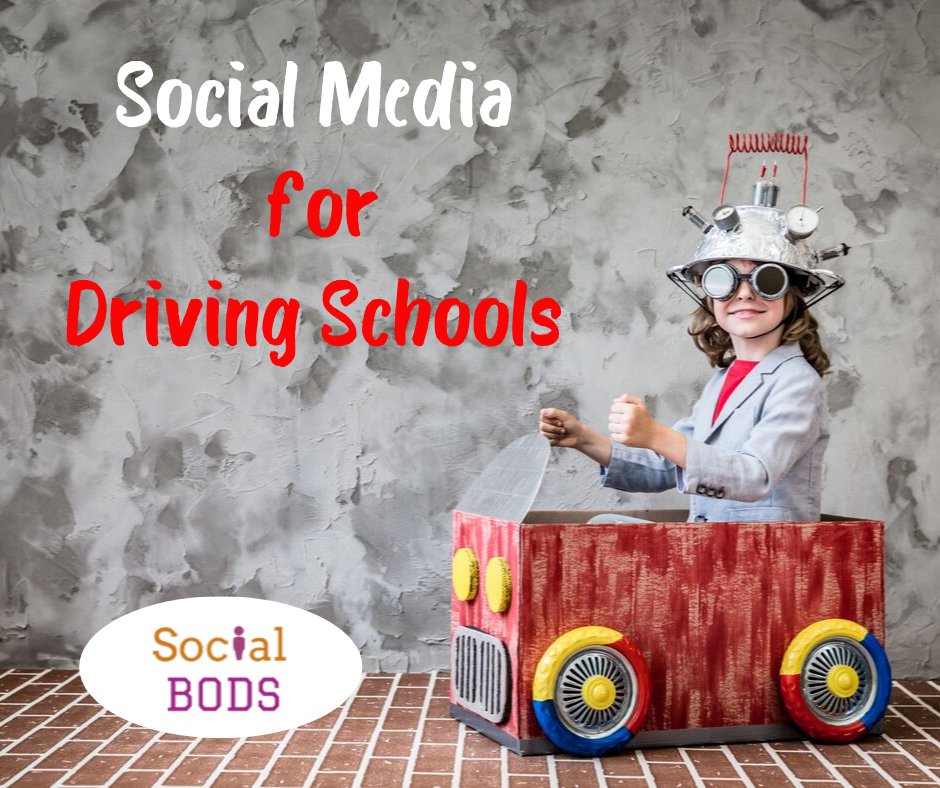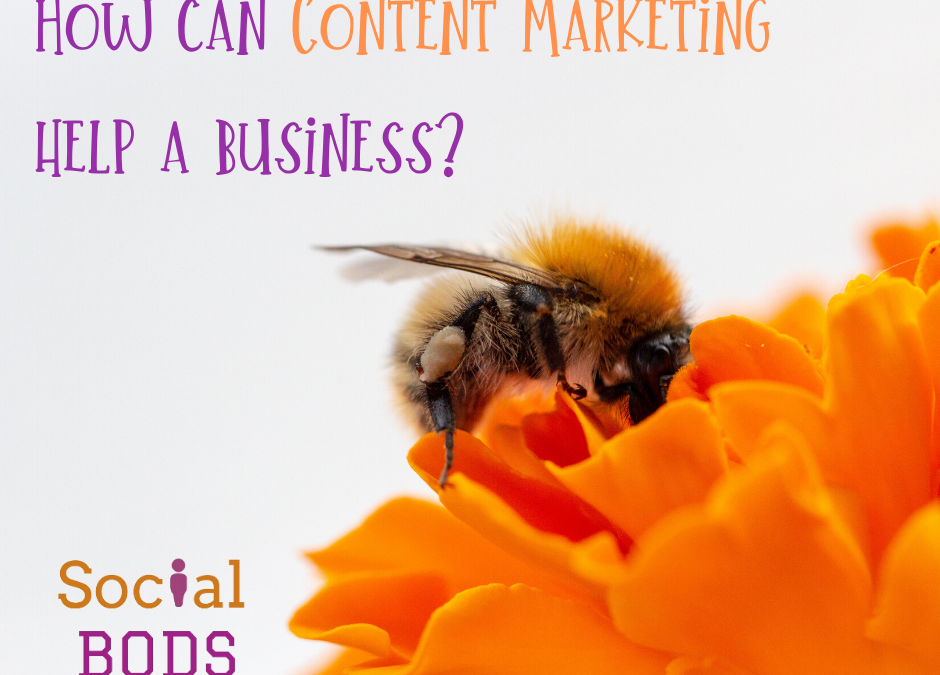You’re here on this site right now, and I’m going to assume it’s because something brought you here. And I’m going to hazard a guess it was this exact piece of content. That’s how content marketing can help a business – getting people who are interested in what you are talking about to come and visit, maybe read something else while they are here, possibly become a fan of your business and, potentially, purchase from you now or in the future.

How content marketing works
Content marketing works by a business producing content which is useful, educational, or entertaining (or a mix of all three) attracting potential customers to their online space. The idea is to create content which is attractive to the business’s ideal client, like a brightly coloured flower attracts a bee. The bee knows what it is looking for and the flower sits there waiting to be the flower of choice. There’s no hard sell involved yet the bee seeks out and visits the flower it suspects best fulfils its needs and does its thing. It might visit other flowers along the way but if your flower is the most useful, the bee will be back. And he might tell all his friends too with that weird bee wiggle-dance thing they do.
Is your business producing content that is attractive to your customers?
What is ‘content’?
Content is generally something like a blog post that sits on a news section on your website, though it can also be free downloads, ebooks and whitepapers, or an infographic, or maybe a video. Social media is, to a large degree, marketing through content, but ‘content marketing’ as we think about it is longer form, more evergreen, and sits on something that you own such as your own website.
Why content marketing is important
Content marketing is important because of the significance in online searches to customers finding what they need. Millions of searches are made on search engines every day, and voice search – via Google Mini Home or Amazon Alexa for example – is on the rise.

Back in the day (yes, I am that old), when we needed anything, we would pick up the Yellow Pages, or the Argos catalogue, or ask a neighbour for a recommendation. Now we have Google and social media. Content marketing helps your business by……
- Having something useful to share on social media which encourages clicks to your site, reinforcing both your site and your social media accounts
- Giving Google (other search engines are available) something fresh to crawl and index and to present as potential search results
- Attracting people who know exactly what they need and helping them to find someone who does exactly what you do at the time they need it
- Engaging with your audience – if you can provide something useful, educational, or entertaining, then this is a good way of turning potentials into customers into brand advocates
- Providing information and ‘how to’ guides about products and services to free up your customer services team
How can content marketing help a business?
Content marketing can help your business as it’s a very, very, very good way of growing your audience in a passive way. While salespeople go out and knock on doors, online content sits there waiting for hungry customers to come to you. While salespeople try to engage customers who don’t even know they want to buy your product yet, content draws in people who are much further up the sales funnel; they know what they want and are actively searching for it right now. Content marketing can bring in a stream of customers who are in a position to purchase.
How to do content marketing
So you know you want to do content marketing, and now you need to know how to do it.
1 – First of all you need an online space. Ideally this would be a blog integrated into your website, however a standalone blog such as a free site provided by Blogger or a free WordPress site will do the job (albeit you won’t legally own the content and the free site can technically be pulled at any moment).
2 – Then you need to consider your audience and the sort of content that would be attractive to them. This requires you to do some work on your customer avatar and have a think around what you could help with that they would find entertaining, useful, or educational. Could you create a free download, or an article about their favourite hobby, or an infographic about their industry for example?
3 – then look at what people are searching for online. One of our favourite tools is the website Answerthepublic.com where you can put in a short phrase and look at some long-tail searches. Can you answer any of the questions that people ask around your topic?
4 – Then look at what people are already searching for on your own site. If you have Google Search Console activated (used to be Google Webmaster tools), you should be able to see the search terms which bring your existing audience to your website. Have your audience had their questions answered sufficiently? Could you be doing something better? Where do you rank for your ideal search term?
5 – Come up with a blog post title and some sub-titles that work around the same theme. If you look at this article as an example, I used Answerthepublic using the term ‘content marketing’ to come up with the title ‘How can content marketing help a business?’ and then subtitles of ‘How can content marketing help a business?‘ and ‘Why content marketing is important‘. Ideally you need to be incorporating keywords that make sense to the asset you want to create. There’s little sense in chucking in popular keyword phrases if your content can’t live up to the hype. If you’re not an expert on cat gifs, then there’s no point in trying to attract people based on their searches for cat gifs. Search engines will get wise to it and punish you, and customers will be turned off by it.
6 – create the content! Easy peasy lemon squeezy. Ok, maybe not…..

How to create a good blog post
So you know what you want to create and have your search terms all figured out. Now is the crucial part of making the content happen.
While there aren’t any hard or fast rules in what a good piece of content looks like, here are some good starting points for creating a good blog post…..
- Try and aim for around 500 words as a minimum. While there is a theory that the more words the better, actually if the content doesn’t warrant it, it’ll just bore people. Consider breaking anything more than 2,000 words into a smaller series. You should certainly try to break up the words with sub-titles, bullet points, and images like I have done on this post.
- Try to include a couple of internal links to other content on your site. Search engines seem to like this and it improves your bounce rate. For example, you might also like to read my article about Social Media V Blogging, or Blogging for Business.
- If appropriate, you should include an outbound link to an authoritative website. The link I have placed above to Answerthepublic fulfils this criterion. But you need to make it useful – don’t send people away from your site for the sake of it.
- Use imagery to break up the text. If you don’t have any original pics you could try a site such as Unsplash or Pixabay to find some good, free stock images.
- Have a call to action on each post. I like to include a link where someone can sign up to our enewsletter (see the bottom of this post). You might prefer to put in a link to your online store, or for more information to a course you’re running, or to come and follow you on Facebook, for example.
- If you use WordPress, you should install the Yoast SEO plug in which can advise you on making your post more search engine friendly, though it is more of a guidance and ‘how to’ than a guarantee that you will be top of Google.
- Include an author box (see bottom of this post). This helps people to understand who you are and makes your content more personable. People buy from people and an author box turns you from a faceless organisation into what that has trustworthy human beings.
- Check the spelling and grammar. If this isn’t your strong point, ask someone else to check over it for you. Here’s our guide to using grammar. In cats.
- Publish to your blog – this can be the sticky point for a lot of people. Make sure you know how to upload and format a blog post on your website, or get someone to do it for you.
What can I blog about?
The idea, particularly if you want long-term traffic from content, is to create content which is ‘evergreen’, that is, it will last beyond the latest buzz and will continue to be relevant this time next year, or even longer.
You need to be thinking about creating content which will be attractive to your potential customers. You need to be creating content which shows you as the expert in whatever it is that you do. Why should potential customers come to you and not to a competitor?
You should also think outside the box a little. If you’re an estate agent in a big city for example, you could post about the current state of the property market in that city, or in the wider country or state, but you could also produce a ‘what’s on guide’ for the city to show it as a great place to live, or a guide to specific areas in your city so someone can make a decision about which part of the city to live. Not all your content has to be specific to property and the property market. Create content which will be attractive to those looking to live and work in the places you sell or let property. Make a name for yourself as someone who’s knowledgeable about your city. Get people who are interested in what’s happening in your city to come to your site. Do you see what I mean?

Check out our post – Social Media for Estate Agents
If you are a driving school, could you be creating content around learning the highway code, or how to tackle tricky manoeuvres? This would be a lot more attractive to people looking to learn to drive than a stream of photos of people passing their tests with you (though these help too!).

Check out our post – Social Media for Driving Schools
Think about incorporating video into your content. Video can be delightfully quick and easy to produce and is far more engaging than straight text. Just remember that it’s hard for search engines to know the exact content of your video so you’ll need to use it as part of a blog post for it to be truly searchable; if you just whack a video in a post with nothing else, it’s doing it a disservice. Look at video as a way of enhancing what you’re talking about rather than being a straight-up substitute.
But I don’t have time to do this!
OK, creating good content takes time. I mean, it took a good two or three hours for me to write this post with the words, links, formatting, finding stock images, and uploading to this site, and I’m pretty fast. But it’s an investment worth making.
When you have downtime in your business and you’re thinking what you can do next that will have a positive impact, then you’d do worse than think about creating some content which could bring you some more customers in the future. It may not be an appropriate time to promote the content right now, but the content can be sat there racking up search engine brownie points until the time is right to promote it.
Should I be promoting my content on social media?
Absolutely yes, unless the answer is no. You need to think about whether your social media audience will be receptive to the content right now. If the timing doesn’t seem right, then share it when it is but if the content is more for search engines than for your social media audience than you don’t need to promote it at all. You need to make the call whether you think the time is right for you. We don’t share everything that we write on our social media channels as it doesn’t seem to fit as well as other bits and we’re happy just to let the content work its SEO magic.
So is content marketing good for business?
Well if you’ve made it this far – and yes I have broken my own rule about a breaking up a post of 2,000 words into smaller posts – then congratulations! Can you see how good content can help create trust in a business by showing potential customers something useful? Will you be back for more of our articles? If you liked this, please sign up to our newsletter, or have a read of something else on the site.
Action plan:-
Go to Answerthepublic right now and start finding three things you can write about!

Joanne Brady is chief bod at Social Bods. Her specialist topics are technology, business, travel, and transport. She is a busy mum and in her spare time she…just kidding, she doesn’t have spare time.

Want to get our newsletter and learn about new events and get free social media help and advice? Register here


